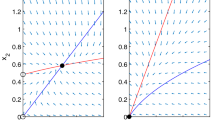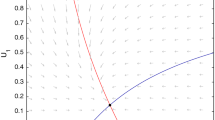Abstract
This paper considers two-species competitive systems with one-species’ diffusion between patches. Each species can persist alone in the corresponding patch (a source), while the mobile species cannot survive in the other (a sink). Using the method of monotone dynamical systems, we give a rigorous analysis on persistence of the system, prove local/global stability of the equilibria and show new types of bi-stability. These results demonstrate that diffusion could lead to results reversing those without diffusion, which extend the principle of competitive exclusion: Diffusion could lead to persistence of the mobile competitor in the sink, make it reach total abundance larger than if non-diffusing and even exclude the opponent. The total abundance is shown to be a distorted function (surface) of diffusion rates, which extends both previous theory and experimental observations. A novel strategy of diffusion is deduced in which the mobile competitor could drive the opponent into extinction, and then approach the maximal abundance. Initial population density and diffusive asymmetry play a role in the competition. Our work has potential applications in biodiversity conservation and economic competition.



Similar content being viewed by others
References
Andren H (1994) Effects of habitat fragmentation on birds and mammals in landscapes with different proportions of suitable habitat: a review. Oikos 71:355–366
Aström J, Pärt T (2013) Negative and matrix-dependent effects of dispersal corridors in an experimental metacommunity. Ecology 94:1939–1970
Gao D, Liang X (2007) A competition-diffusion system with a refuge. Disc Cont Dyn Syst-B 8:435–454
Gilbert F, Gonzalez A, Evans-Freke I (1998) Corridors maintain species richness in the fragmented landscapes of a microecosystem. Proc R Soc Lond B 265:577–582
Hofbauer J, Sigmund K (1998) Evolutionary games and population dynamics. Cambridge University Press, Cambridge
Holt RD (1985) Population dynamics in two-patch environments: some anomalous consequences of an optimal habitat distribution. Theor Popul Biol 28:181–207
Lopez L, Sanjuan MAF (2001) Defining strategies to win in the Internet market. Phys A 301:512–534
Perko L (2001) Differential equations and dynamical systems. Springer, New York
Poggiale JC (1998) From Behavioural to Population level: growth and competition. Math Comput Model 27:41–50
Ruiz-Herrera A (2018) Metapopulation dynamics and total biomass: understanding the effects of diffusion in complex networks. Theor Popul Biol 121:1–11
Ruiz-Herrera A, Torres PJ (2018) Effects of diffusion on total biomass in simple metacommunities. J Theor Biol 447:12–24
Smillie J (1984) Competitive and cooperative tridiagonal systems of differential equations. SIAM J Math Anal 15:530–534
Smith HL (1986) Competing subcommunities of mutualists and a generalized Kamke theorem. SIAM J Appl Math 46:856–874
Smith HL (1988) Systems of ordinary differential equations which generate an order preserving flow: a survey of results. SIAM Rev 30:87–113
Smith HL (1995) Monotone dynamical systems: an introduction to the theory of competitive and cooperative systems, vol 41. Mathematical surveys and monographs. American Mathematical Society, Providence
Soulé ME, Gilpin ME (1991) The theory of wildlife corridor capability. Nat Cons 2:3–8
Takeuchi Y (1986) Global stability in generalized Lotka–Volterra diffusion systems. J Math Anal Appl 116:209–221
Takeuchi Y (1989) Diffusion-mediated persistence in two-species competition Lotka–Volterra model. Math Biosci 95:65–83
Takeuchi Y (1990) Conflict between the need to forage and the need to avoid competition: persistence of two-species model. Math Biosci 99:181–194
Takeuchi Y (1992) Refuge-mediated global coexistence of multiple competitors on a single resource, Recent trends in differential equations. WSSIAA 1:531–541
Takeuchi Y, Zhengyi L (1995) Permanence and global stability for competitive Lotka–Volterra diffusion systems. Nonlinear Anal TMA 24:91–104
Wilkinson JH (1965) The algebraic eigenvalue problem. Oxford University Press, Oxford
Wu H, Wang Y, Li Y, DeAngelis DL (2020) Dispersal asymmetry in a two-patch system with sourcesink populations. Theor Popul Biol 131:54–65
Zhang B, Liu X, DeAngelis DL, Ni W-M, Wang GG (2015) Effects of dispersal on total biomass in a patchy, heterogeneous system: analysis and experiment. Math Biosci 264:54–62
Zhang B, Alex K, Keenan ML, Lu Z, Arrix LR, Ni W-M, DeAngelis DL, Van Dyken JD (2017) Carrying capacity in a heterogeneous environment with habitat connectivity. Ecol Lett 20:1118–1128
Zhang B, DeAngelis DL, Ni WM, Wang Y, Zhai L, Kula A, Xu S, Van Dyken JD (2020) Effect of stressors on the carrying capacity of spatially-distributed metapopulations. Am Nat 196:46–60
Acknowledgements
We would like to thank two anonymous reviewers for their careful reading and helpful comments on the manuscript. This work was supported by NSF of P.R. China (12071495, 11571382).
Author information
Authors and Affiliations
Corresponding author
Additional information
Publisher's Note
Springer Nature remains neutral with regard to jurisdictional claims in published maps and institutional affiliations.
Rights and permissions
About this article
Cite this article
Wu, H., Wang, Y. Dynamics of Competitive Systems with Diffusion Between Source–Sink Patches. Bull Math Biol 83, 49 (2021). https://doi.org/10.1007/s11538-021-00885-5
Received:
Accepted:
Published:
DOI: https://doi.org/10.1007/s11538-021-00885-5




